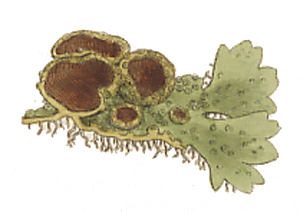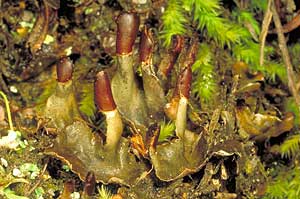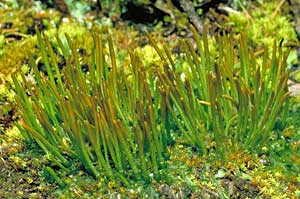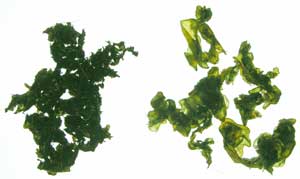
What is a bryophyte? – What's not a bryophyte?
Other cryptogams
Bryophytes rarely grow in isolation. It's more usual to find bryophytes growing with some of the other cryptogams and it's easy to confuse some of them with bryophytes when you are just beginning to learn about bryophytes. After a while you begin to recognize some of the commoner "look-alikes" in the field, but even experienced bryologists occasionally get confused. The only solution is to take a specimen back home and look at it closely, perhaps with a microscope, to be sure of what it is.
This page will deal briefly with some of these other cryptogam groups that you might confuse with bryophytes. This page won't tell you how to tell them apart from bryophytes. Sometimes it's very easy, sometimes it's not. Rather, the aim is to make you aware of these other organisms and give you some references to further information, photographs in particular. You can learn a lot by looking carefully at photographs.
Ferns and fern-allies
Of the other cryptogams the smaller ferns and fern-allies are most likely to be confused with bryophytes. They, like bryophytes, are plants and mostly coloured green. Compare the following two photographs, one of a filmy fern, the other a liverwort. They look similar and even their names are similar! Here's ![]() Hymenophyllum flabellatum, a filmy fern and here
Hymenophyllum flabellatum, a filmy fern and here ![]() is Hymenophyton flabellatum, a liverwort. In this photo
is Hymenophyton flabellatum, a liverwort. In this photo ![]() you can see the aquatic fern Azolla filiculoides (with reddish tinges) and an aquatic liverwort, Ricciocarpus natans (green).
you can see the aquatic fern Azolla filiculoides (with reddish tinges) and an aquatic liverwort, Ricciocarpus natans (green).
Sometimes, rather than mistaking a fern for a bryophyte, the reverse happens. The stems of the moss Spiridens vieillardi ![]() often grow 20-30 centimetres long, are quite robust and a clump of Spiridens could be mistaken for a fern by somebody who thinks of mosses only as tiny plants. Among the cryptogams the ferns and fern-allies are the odd ones out because they, like the flowering plants, have well-developed conducting, or vascular, systems for moving water and nutrients from one part of the plant to another. Ferns and fern-allies are therefore examples of vascular cryptogams. Bryophytes are non-vascular cryptogams.
often grow 20-30 centimetres long, are quite robust and a clump of Spiridens could be mistaken for a fern by somebody who thinks of mosses only as tiny plants. Among the cryptogams the ferns and fern-allies are the odd ones out because they, like the flowering plants, have well-developed conducting, or vascular, systems for moving water and nutrients from one part of the plant to another. Ferns and fern-allies are therefore examples of vascular cryptogams. Bryophytes are non-vascular cryptogams.
Here's a website with a lot more about ferns and fern-allies![]() .
.
Lichens
A lichen is not a single organism - but a very intimate partnership between a fungus and a photosynthesizing organism. The latter is called the photobiont and may be an alga or a cyanobacterium. Lichens come in a wide variety of forms as explained here.
Lichens are not plants and are classified as fungi. Lichens never have leaves on stems so should not be confused with mosses or leafy liverworts. Many lichens have a flattish, somewhat sheet-like growth form, called a thallus. When green, such as the one shown in the painting at the top of this page, you might confuse them with hornworts or thallose liverworts. You might initially suppose that the brown disks on the lichen thallus in that painting are gemma cups, such as the ones you find in the THALLOSE LIVERWORTS of the genus Marchantia ![]() . However, gemma cups are green and often have some gemmae in them, a means of VEGETATIVE REPRODUCTION. You'll never see any gemma-like granules on the surfaces of those flat disks on lichen thalli. Below the surface of such a disk the fungal partner produces microscopic spores. If you have a hazy recollection that a hornwort has finger-like growths from a flattish base, you could confuse a lichen of the genus Peltigera with a hornwort.
. However, gemma cups are green and often have some gemmae in them, a means of VEGETATIVE REPRODUCTION. You'll never see any gemma-like granules on the surfaces of those flat disks on lichen thalli. Below the surface of such a disk the fungal partner produces microscopic spores. If you have a hazy recollection that a hornwort has finger-like growths from a flattish base, you could confuse a lichen of the genus Peltigera with a hornwort.
There's more in the WHAT IS A HORNWORT? page.
In the bulk of lichen species the thallus is layered internally. The uppermost layer is thin and composed of densely packed fungal tissue. Below that is the photobiont layer, green if algal and bluish-green if cyanobacterial. Below that is a thicker layer of loosely arranged fungal tissue and finally, at the bottom, there's often another layer of densely packed fungal tissue. If you carefully scratch the upper surface of a lichen thallus with a needle you'll expose the green or blue-green photobiont layer. If you scratch past that you'll expose the next fungal layer, typically white. You won't find a white layer inside the thallus of a hornwort or a thallose liverwort![]() .
.
Algae and cyanobacteria
Many algae are green and often grow in dense masses and may look "mossy" on an initial glance. Algae don't occur only in water. Some species are fairly common in sheltered terrestrial habitats.
|
Cyanobacteria vary in shape and are bluish-green to khaki-coloured when moist, but brittle and blackish when dry. You may sometimes see cyanobacteria mistakenly called "blue-green algae", but cyanobacteria are quite distinct from algae. The photo (right) shows Nostoc, both dry and wet, from the Australian National Botanic Gardens, where it's fairly common in the rockery and in the mallee plantings.
This is a useful website for more information about algae and cyanobacteria.![]()
![An Australian Government Initiative [logo]](/images/austgovt_brown_90px.gif)




